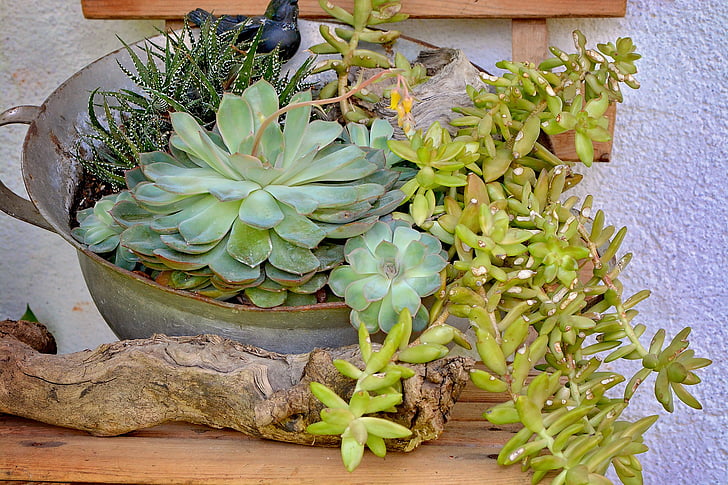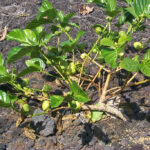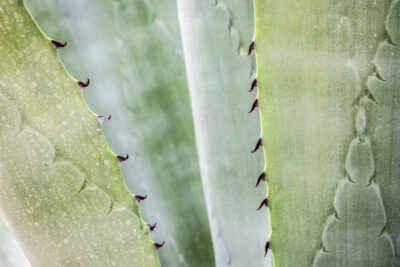
Trimming Succulents: Can I Safely Prune the Top of an Overgrown Plant?

Succulents are a popular choice for indoor and outdoor gardening due to their unique shapes, vibrant colors, and easy maintenance. However, over time, these plants can become overgrown, with their tops growing out of proportion to the rest of the plant. This raises the question: can you safely prune the top of an overgrown succulent without causing harm?
We will explore the topic of trimming succulents and whether it is safe to prune the top of an overgrown plant. We will discuss the reasons why succulents may become overgrown and the potential risks and benefits of trimming them. Additionally, we will provide step-by-step instructions on how to properly trim a succulent to maintain its health and aesthetic appeal. By the end of this article, you will have a better understanding of how to care for your overgrown succulents and keep them looking their best.
- Yes, you can safely prune the top of an overgrown succulent
- Pruning will encourage new growth and help maintain the plant's shape
- Use clean, sharp scissors or pruning shears to make the cuts
- Make clean cuts close to a node or joint to promote healthy regrowth
- Remove any dead or yellowing leaves while pruning
- Allow the cuttings to dry for a few days before replanting or propagating
- Apply a rooting hormone to the cut ends to encourage faster rooting
- Repot the pruned succulent in well-draining soil after it has rooted
- Water the plant sparingly after pruning to avoid overwatering
- Frequently Asked Questions
Yes, you can safely prune the top of an overgrown succulent
When it comes to maintaining the health and appearance of your succulent, pruning is an essential task. If you find yourself with an overgrown succulent, don't worry - you can safely prune the top to help it thrive.
Why should you prune an overgrown succulent?
Over time, succulents can grow leggy and top-heavy, which not only affects their aesthetic appeal but also their overall health. Pruning the top not only helps to maintain a more compact and attractive shape but also encourages new growth from the base, resulting in a healthier and more robust plant.
How to safely prune the top of an overgrown succulent:
 Can Succulents Survive a Freeze Unprotected?
Can Succulents Survive a Freeze Unprotected?- Prepare your tools: Before you begin, make sure you have a pair of clean and sharp pruning shears or scissors. This will ensure a clean cut and minimize the risk of damaging the plant.
- Identify the top: Look for the part of the succulent that appears leggy or elongated. This is the section you'll be pruning.
- Choose the right time: It's best to prune your succulent during its active growing season, which is typically in spring or summer. This allows the plant to recover more quickly and promotes new growth.
- Make the cut: Position your pruning tool just above a leaf node or joint, and make a clean, diagonal cut. Avoid cutting too close to the base of the plant to prevent damage.
- Remove excess foliage: If your succulent has any leaves or branches that are dead, damaged, or overcrowded, now is a good time to remove them. This will help improve air circulation and prevent diseases.
- Allow the wound to heal: After pruning, it's important to let the cut area dry and callus over for a few days before watering the plant. This reduces the risk of infection and ensures proper healing.
What to do with the pruned top:
Don't let the pruned top go to waste! After you've trimmed your succulent, you can propagate the cuttings to grow new plants. Simply let the cut end dry and callus over for a few days, then place it in well-draining soil and give it some time to take root.
Remember, pruning is a beneficial practice for your succulents, helping them stay healthy and maintain their desired shape. With the right tools and techniques, you can safely trim the top of an overgrown succulent and enjoy a thriving plant collection.
Pruning will encourage new growth and help maintain the plant's shape
When it comes to succulents, pruning can be a beneficial practice to encourage new growth and maintain the plant's shape. If you find that your succulent has become overgrown or has started to lose its compact form, trimming the top can help restore its aesthetic appeal.
However, it's important to approach pruning with caution, as succulents have unique growth patterns and characteristics that need to be considered. Before grabbing your pruning shears, it's essential to understand the proper technique and timing to ensure the safety and health of your succulent.
Why should you prune succulents?
Pruning succulents serves multiple purposes. Firstly, it helps remove any dead or dying leaves, stems, or flowers, keeping your succulent looking tidy and preventing the spread of diseases or pests. Additionally, pruning can stimulate the growth of new branches or offsets, allowing your succulent to develop a fuller and more attractive appearance.
 Protecting Succulents: Tips for Cold Weather Survival
Protecting Succulents: Tips for Cold Weather SurvivalWhen is the best time to prune succulents?
The best time to prune your succulent depends on the specific variety and its growth cycle. In general, it's recommended to prune during the active growing season, which is usually in spring or summer when succulents are actively producing new growth. Pruning during this time allows the plant to recover quickly and promotes healthy regrowth.
How to safely prune the top of an overgrown succulent?
Before you start pruning, gather the necessary tools such as clean pruning shears or scissors. It's crucial to sanitize your tools to prevent the transmission of diseases or infections to the plant. You can do this by wiping the blades with rubbing alcohol or a diluted bleach solution.
To safely prune the top of an overgrown succulent, follow these steps:
- Identify the areas that need trimming. Look for leggy or elongated stems, dead leaves, or any parts that are obstructing the desired shape of the plant.
- Using the sterilized pruning shears or scissors, make clean cuts just above a node or leaf joint. Avoid leaving stubs, as they can invite pests or diseases.
- If you want to propagate your succulent, save the cuttings for propagation. Allow the cuttings to dry for a few days or until calloused before planting them in well-draining soil.
- After pruning, allow the plant some time to recover and heal before watering. Overwatering immediately after pruning can lead to root rot or other issues.
Note: Different succulent varieties may have specific pruning requirements, so it's always a good idea to research the specific needs of your succulent before pruning.
Pruning the top of an overgrown succulent can be done safely and effectively if done correctly. By following the proper techniques and timing, you can encourage new growth and maintain the desired shape of your succulent, ensuring its overall health and aesthetic appeal.
Use clean, sharp scissors or pruning shears to make the cuts
When it comes to trimming succulents, it's important to have the right tools for the job. To safely prune the top of an overgrown succulent plant, you'll need clean, sharp scissors or pruning shears. This will ensure clean cuts and minimize the risk of damaging the plant.
 Using Regular Miracle Gro Fertilizer: Is it Suitable for Succulents?
Using Regular Miracle Gro Fertilizer: Is it Suitable for Succulents?Make clean cuts close to a node or joint to promote healthy regrowth
When it comes to trimming succulents, many gardeners wonder if they can safely prune the top of an overgrown plant. The good news is that yes, you can! Trimming the top of a succulent can help promote new growth and keep the plant looking healthy and compact.
However, it's important to approach pruning with care to ensure the best results. One key tip is to make clean cuts close to a node or joint. Nodes are the points on a succulent's stem where leaves or branches emerge. By cutting close to a node, you encourage the plant to produce new growth from that point.
Tools you'll need:
- Pruning shears: Use a sharp pair of pruning shears to make clean cuts without crushing the plant's tissue.
- Gloves: Protect your hands from potential thorns or prickles that some succulents may have.
- Disinfectant: Before and after pruning, sanitize your tools with a disinfectant to prevent the spread of diseases.
Step-by-step guide to safely trimming succulents:
- Assess the plant: Take a close look at your succulent and identify which parts need to be pruned. Look for leggy stems, damaged leaves, or any signs of disease.
- Prepare your tools: Ensure your pruning shears are clean and sharp. Dip them in a disinfectant solution and let them dry before use.
- Choose the right time: It's best to prune succulents during their active growing season, typically in spring or early summer.
- Make the cuts: Locate a node or joint just below where you want to prune. Position your pruning shears close to the node and make a clean cut. Avoid leaving any stubs, as they can become susceptible to rot.
- Monitor and care for the plant: After pruning, keep an eye on your succulent to ensure it is regrowing properly. Provide adequate sunlight, water, and well-draining soil to support healthy growth.
Remember, not all succulents require regular pruning. Some varieties naturally maintain a compact shape without much intervention. However, if your succulent has become leggy or overgrown, trimming can help rejuvenate its appearance and promote healthy regrowth.
By following these guidelines and making clean cuts close to nodes or joints, you can safely prune the top of an overgrown succulent and enjoy a more visually appealing plant.
Remove any dead or yellowing leaves while pruning
Why is it important to remove dead or yellowing leaves?
When trimming succulents, it is essential to remove any dead or yellowing leaves. These leaves can indicate that the plant is not receiving enough sunlight or that it is being overwatered. By removing these leaves, you not only improve the overall appearance of the plant but also promote its health and growth.
Dead or yellowing leaves can attract pests and diseases, which can spread to the rest of the plant if left untreated. Removing them prevents the further spread of any potential issues and helps maintain the plant's vitality.
 Succulent Care on Wood: A Guide to Proper Maintenance
Succulent Care on Wood: A Guide to Proper MaintenanceAdditionally, dead or yellowing leaves can hinder the succulent's ability to absorb sunlight and nutrients. By removing them, you allow the plant to focus its energy on healthy growth and development.
How to safely remove dead or yellowing leaves
To safely remove dead or yellowing leaves from a succulent, follow these steps:
- Gather the necessary tools: You will need a pair of clean and sharp scissors, pruning shears, or a clean knife. Ensure that the tools are disinfected to prevent the spread of any potential diseases.
- Identify the dead or yellowing leaves: Inspect the succulent carefully to identify any leaves that are discolored, wilted, or shriveled. These are the leaves that need to be removed.
- Hold the leaf near its base: Gently hold the leaf near its base, where it connects to the stem or rosette. Be careful not to damage the healthy leaves or the stem.
- Cut or remove the leaf: Using clean and sharp tools, make a clean cut at the base of the leaf or gently pull it away from the stem. Ensure that you remove the entire leaf, including any portion attached to the stem.
- Dispose of the removed leaves: Place the removed leaves in a compost bin or discard them in a proper manner. Do not leave them near the succulent, as they can attract pests or diseases.
When is the best time to remove dead or yellowing leaves?
While you can remove dead or yellowing leaves from succulents at any time, it is generally recommended to do so during the plant's active growing season, which is typically in spring or summer. During this time, succulents are more resilient and better equipped to heal and recover from the pruning process.
However, if you notice any severely damaged or diseased leaves, it is advisable to remove them immediately, regardless of the season. Promptly removing such leaves can prevent the spread of pests or diseases to other parts of the plant.
Remember to always monitor the overall health of your succulents and address any issues promptly to ensure their long-term well-being.
Allow the cuttings to dry for a few days before replanting or propagating
Can I Safely Prune the Top of an Overgrown Succulent?
If you have an overgrown succulent that is starting to look unruly, you may be wondering if it's possible to safely prune the top of the plant. The good news is that, in most cases, you can safely trim succulents without causing harm to the plant. However, there are a few important things to keep in mind to ensure successful pruning and minimize the risk of damage.
 Reviving an Overwatered Succulent: Tips to Save Your Plant
Reviving an Overwatered Succulent: Tips to Save Your Plant1. Choose the Right Time
It's best to prune your succulent during its active growth period, which is typically in spring or summer. Avoid pruning during the dormant season, as this can slow down the plant's recovery and growth.
2. Use Clean and Sterilized Tools
Before you begin pruning, make sure your tools are clean and sterilized. This helps prevent the spread of diseases and ensures a clean cut. You can sterilize your tools by wiping them down with rubbing alcohol or dipping them in a solution of one part bleach to nine parts water.
3. Trim with Care
When trimming the top of your succulent, use sharp, clean scissors or gardening shears. Start by identifying the section you want to remove and make a clean cut just above a leaf node or joint. Avoid tearing or ripping the plant, as this can create open wounds that are more susceptible to infections.
4. Allow the Cuttings to Dry
 Succulent Care: Pruning Damaged Leaves
Succulent Care: Pruning Damaged LeavesAfter pruning, it's important to allow the cuttings to dry for a few days before replanting or propagating. This allows the cuts to callus over, which helps prevent rotting. Place the cuttings in a dry and shaded area, away from direct sunlight.
5. Replant or Propagate
Once the cuttings have callused, you can replant them in well-draining soil or propagate them to create new plants. Ensure that the soil is dry before planting the cuttings to prevent rot.
6. Provide Proper Care
After pruning, be sure to provide your succulent with the right care. This includes placing it in a bright location with indirect sunlight and watering it sparingly, allowing the soil to dry out between waterings. Avoid overwatering, as this can lead to root rot.
By following these steps, you can safely prune the top of an overgrown succulent and encourage healthier growth. Remember, each succulent species may have specific care requirements, so it's always a good idea to research and understand the needs of your particular plant before pruning.
Apply a rooting hormone to the cut ends to encourage faster rooting
 The Ultimate Guide to Succulent Care: Everything You Need to Know
The Ultimate Guide to Succulent Care: Everything You Need to KnowWhen it comes to trimming succulents, one important step to consider is applying a rooting hormone to the cut ends of the plant. Rooting hormones contain growth-promoting substances that help stimulate root development and improve the chances of successful propagation.
Before applying the rooting hormone, it is crucial to first make clean, precise cuts on the overgrown succulent. Use a sharp and sterile pair of pruning shears to ensure a smooth and healthy cut. Once you have made the necessary cuts, dip the cut ends of the succulent in the rooting hormone.
Rooting hormones are available in different forms, such as powders, gels, and liquids. Choose the type that suits your preference and follow the instructions provided by the manufacturer for the best results. The rooting hormone helps to speed up the process of root formation, which is essential for the succulent to establish itself in its new environment.
By applying a rooting hormone, you can increase the chances of successful propagation and ensure that your pruned succulent develops a strong and healthy root system.
Repot the pruned succulent in well-draining soil after it has rooted
Once you have successfully pruned your overgrown succulent, it is important to repot it in well-draining soil. This step is crucial to ensure the health and proper growth of your plant.
First, choose a new pot that is slightly larger than the previous one. This will provide your succulent with enough space to grow and develop its roots. Additionally, make sure the new pot has drainage holes at the bottom to prevent water from accumulating and causing root rot.
 Preventing Succulent Stem Growth: Tips for Compact, Healthy Plants
Preventing Succulent Stem Growth: Tips for Compact, Healthy PlantsNext, prepare the well-draining soil mixture for your succulent. A popular choice is a combination of potting soil, perlite, and coarse sand. This blend allows for adequate drainage while still retaining enough moisture for the plant.
Before repotting, it is essential to allow the pruned succulent to root. This process typically takes a few days to a couple of weeks, depending on the plant's variety and condition. During this time, place the pruned succulent in a dry location away from direct sunlight. This will encourage root development and prevent any potential rotting.
Once the succulent has rooted, carefully remove it from its old pot. Gently loosen the soil around the roots, being cautious not to damage them. If there are any dead or rotting roots, trim them off to promote healthy growth.
Place a layer of well-draining soil in the bottom of the new pot, ensuring it covers the drainage holes. Then, position the succulent in the center of the pot and fill in the remaining space with the soil mixture. Press the soil gently around the roots to secure the plant in place.
After repotting, it is crucial to refrain from watering the succulent immediately. Wait for a few days to allow the plant to adjust to its new environment and minimize the risk of root rot. Once the waiting period is over, water the succulent sparingly, ensuring the soil is completely dry between waterings.
Remember to place the repotted succulent in a location with adequate sunlight, as different varieties have varying light requirements. With proper care and maintenance, your pruned succulent will soon thrive and continue to bring beauty to your indoor or outdoor space.
Water the plant sparingly after pruning to avoid overwatering
 Revive Your Dying Succulent with These Essential Tips
Revive Your Dying Succulent with These Essential TipsTrimming succulents is a common practice to maintain the health and appearance of these resilient plants. However, many succulent owners often wonder if it is safe to prune the top of an overgrown plant. The answer to this question depends on various factors, such as the type of succulent, its overall condition, and the desired outcome.
1. Assess the health of your succulent
Before you proceed with trimming the top of your overgrown succulent, it is essential to assess its health. Look for any signs of disease or pest infestation. If your succulent appears unhealthy, it is recommended to address these issues before pruning. Pruning a sick plant may further weaken it and hinder its ability to recover.
2. Consider the type of succulent
Each succulent species has its own growth habits, and some may respond better to pruning than others. While most succulents can tolerate some degree of trimming, there are a few exceptions. For example, certain rosette-forming succulents, like Echeveria, may not respond well to having their tops pruned. It is advisable to research the specific needs of your succulent species before proceeding with any pruning.
3. Prune with caution
When pruning the top of an overgrown succulent, it is important to proceed with caution. Start by using clean and sharp pruning shears or scissors to avoid causing unnecessary damage to the plant. Trim the top portion of the succulent, removing any leggy or elongated growth. Ensure that you make clean cuts just above a leaf node or joint to encourage new growth.
 Causes of Brown and Falling Bottom Leaves in Succulents
Causes of Brown and Falling Bottom Leaves in Succulents4. Allow time for healing
After pruning, it is crucial to allow the succulent time to heal before exposing it to excessive moisture or direct sunlight. Place the pruned succulent in a shaded area for a few days to prevent sunburn or dehydration. This will also minimize the risk of fungal or bacterial infections. Water the plant sparingly during this healing period to avoid overwatering, as succulents are prone to root rot when sitting in damp soil.
5. Monitor and adjust care routine
After pruning, keep a close eye on your succulent's progress. Monitor how it responds to the pruning and adjust its care routine accordingly. This may include adjusting the watering frequency, providing sufficient sunlight, and ensuring proper air circulation around the plant. By closely observing your succulent, you can make any necessary adjustments to promote healthy regrowth.
Trimming the top of an overgrown succulent can be done safely if you assess the plant's health, consider the type of succulent, and prune with caution. By giving your succulent time to heal and monitoring its progress, you can encourage new growth and maintain a healthy and visually appealing plant.
Frequently Asked Questions
1. Can I safely prune the top of an overgrown succulent?
Yes, you can safely prune the top of an overgrown succulent. Just make sure to use clean, sharp tools and avoid cutting too close to the base to prevent damage to the plant.
2. How much can I trim off my overgrown succulent?
You can trim off up to one-third of the plant's height or length. This will help maintain the plant's shape and prevent it from becoming too leggy.
3. When is the best time to prune an overgrown succulent?
The best time to prune an overgrown succulent is during its active growing season, which is typically in spring or early summer. Avoid pruning in winter when the plant is dormant.
4. How do I care for a pruned succulent after trimming?
After trimming, allow the cut ends to dry and callus over for a few days before planting them or re-potting the main plant. Make sure to provide appropriate sunlight, water, and well-draining soil for healthy regrowth.
If you want to read more articles similar to Trimming Succulents: Can I Safely Prune the Top of an Overgrown Plant?, you can visit the Care and Maintenance category.






You Must Read